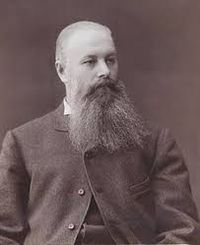Vasily Dokuchaev
Early Life
Vasily Dokuchaev was born in 1846 in Milyukovo, Russia [3]. Upon beginning higher education at the Theology Seminary in St. Petersburg, he quickly found that his interests lay more in the hands-on nature of the natural sciences, rather than religion and theology. This lead him into the world of geology, in which he gained his doctorate.[2]

Achievements
Often considered the father of modern pedology, Dokuchaev held many positions that allowed him to continue honing his craft. He became the Curator of St. Petersburg University's geology laboratory in 1872 [2]. This position later led him to become a professor of geology at the university [3]. In addition to this position, he also took the time from 1892-1895 to reorganize and direct the Novo-Alexsandr Institute of Agriculture and Forestry [3]. These positions allowed him to get himself involved in the creation of courses, and interest, in the growing field of soil science in Russia.
Dokuchaev's crowning achievement may have been his direct work with soil. In 1876, the Free Economic Society chose Dokuchaev to conduct the first ever survey of Russian chernozem, or prairie soil. His instructions were simple: gather data that can be used to explain the soils structure, origin, and evolution. Upon doing his research, he realized that soil, just as organisms, is an incredibly complex and independent thing. He brought up the ideas that things such as maternal rock variety, land age, climate and vegetation can all work together in a way that can make soil types their own individual thing. Due to the different factors he acknowledged were a part of what makes soil that way it is, he is often considered to be a founding force behind Hans Jenny's State Factor Model, which is sometimes referred to as the Jenny Equation [2].
S = f(cl, o, r, p, t, ...)
The information and skills he learned during his time working with chernozem gave him valuable insight when taking on another important project in 1891. Due to severe drought that effected these prairie lands, he was commissioned by the Ministry of State Lands to work on a study that would give insight on proper land and water management for times like those happening [1]. He studied three experimental plots within the area, using meteorological stations and rain-gauges to collect data. Using this data, Dokuchaev was able to conclude ways in which the surrounding landscape could be more effectively managed to allow for less stress when droughts or similar natural disasters were to occur. His findings led to forest re-cultivation, water management and regulations, and reservoir construction [1].
Impacts On Pedology
Western soil science, specifically in the United States, was coming along during the late 1800s-early 1900s. Despite its progress, there was an overwhelming recognition that the contributions of Russian soil scientists, such as Dokuchaev, would be of great importance to its continued growth. Due to language barriers, the access to this information was stalled until the 1910's. It was with the publication and translation into first, German in 1914, and then English in 1917, of Die Hypen der Bodenbildung by Konstantin Glinka who was a student of Dokuchaev's, that the western world finally gained access to Eastern ideas on pedogenesis [2]. With the new influx of Russian pedology, the United States ecological community began incorporating different concepts from said work, with the earliest influenced work in publication being written by Charles Shaw.
Dokuchaev may also be credited with the creation of a new way to classify soils. This new classification stemmed from his discovery of the way soil systems work independently. The factors that make this up are climate, bedrock, plant and animal life, land history and topography of the area. Look familiar? That's because these are the very same factors that Hans Jenny used to formulate the State Factor Model. Dokuchaev believed that way soil is classified should be based on its natural history [1].
References
1. 2008, Complete Dictionary of Scientific Biography, Vasily Vasilievich Dokuchaev, Volume 4: Detroit, MI, Charles Scribner’s Sons, p. 143-146.
2. Jenny, R. A. a. H., 1997, On a State Factor Model of Ecosystems: BioScience, v. 47, p. 536-543.
3. Britannica, T. E. o. E., Vasily Vasilyevich Dokuchayev, Volume 2019, Encyclopaedia Britannica, p. Biography.